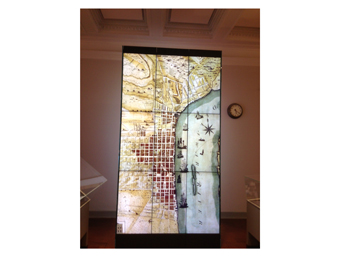Philadelphia, Pennsylvania, holds a very special place in the annals of U.S. history. It is the birthplace of the Declaration of Independence as well as the U.S. Constitution, and was home to significant figures such as Founding Father Benjamin Franklin, Revolutionary War icon Betsy Ross, author Louisa May Alcott, Civil War General George B. McClellan and comedian/actor Bill Cosby. So when you’re entrusted with preserving all of that important history for the benefit of citizens of the present, you don’t take that mission lightly.
Such is the world of the Historical Society of Pennsylvania (HSP). Founded in 1824 and located at 1300 Locust Street in a building designed by native son architect Addison Hutton, HSP is home to some 600,000 printed items and more than 21 million manuscript and graphic items encompassing more than 350 years of American history, dating from the city’s seventeenth century origins to today (including a handwritten first draft of the U.S. Constitution, the earliest surviving American photograph, a copy of the Emancipation Proclamation signed by Abraham Lincoln, and a document with the lyrics to “The Star-Spangled Banner,” handwritten and signed by author Francis Scott Key—one of only three known to exist.).
Because of the fragile nature of the majority of these national treasures, most of the collection is stored in dark, climate-controlled rooms, hidden from public view. Individual pieces are normally seen exclusively by HSP’s typical patrons who tend to be researchers (genealogists, K-12 teachers, college/university researchers, and historical/heritage organizations). HSP also displays samples from its collection in four exhibit cases—but only for a very limited time to prevent damage.
The Challenge
In 2012, HSP was preparing to embark on a $5.7 million building renovation project—its first in 20 years.
The project had several components. One was to upgrade the security system to protect its invaluable collection. Another was to install compact shelving in three storage areas that would take HSP from bursting at the seams to having enough space to grow its collection for another ten years without increasing its footprint. The third involved updating the public spaces, lobby area, and reference room.
“We wanted to enhance our visibility and make HSP a more welcoming space for visitors,” says Page Talbott, interim president and CEO of the Historical Society of Pennsylvania. “We have such a rich collection of documents and other artifacts, yet only a small segment of the population had seen it or was even aware of it. We wanted to draw more of the general public to HSP and help make history come alive for them.
“America is still such a young country relative to much of the world, and always seems to be looking to the future. Gaining a glimpse of the past creates a perspective that anchors us and binds us to all those who blazed the trails we’re now following.”
To gain a sense of how other historical societies, museums, and places of interest approached engaging their visitors, several members of HSP embarked on a tour of various locations in the United States and Europe. They looked at the overall flow, ambience, and display presentations, noting what they liked and what they thought was effective. Among their discoveries was the idea of a video wall.
“The building committee could see a lot of possibilities in it,” says Talbott. “The motion, the bright colors, and the size would all help make the materials in our collection larger than life—figuratively as well as literally. The fact that we could show multiple pieces in the same space or create a montage that told a more detailed story would also be a huge benefit.
“Of course, video would certainly be more attractive to our younger visitors who have grown up looking at screens all their lives, helping them relate to our collection more readily than they might have just looking at the artifacts themselves.”
 At first, the concept of a video wall was on the “nice to have” list. But as renovation plans progressed, HSP determined it was definitely something they wanted to make a part of the new public space. In fact, they wanted three.
At first, the concept of a video wall was on the “nice to have” list. But as renovation plans progressed, HSP determined it was definitely something they wanted to make a part of the new public space. In fact, they wanted three.
HSP spoke with Lead Architect Peter Saylor as well as David Searles, both of the firm SaylorGregg Architects, about how to integrate the video walls into the public spaces.
Once that was decided, Designer Stephen Bashore of Cloud Gehshan Associates (CGA) was brought in to design a stand that would incorporate two back-to-back video displays in a 3×3 configuration that fit aesthetically with the rest of the space. CGA also proposed designing a 2×2 video wall for donor recognition, which would be incorporated into the permanent donor wall. CGA created the screen layouts and standards that determine where content goes and how it will be presented.
All that was left was to determine which display screens to use. They had to have high reliability because they would be running for long periods of time, and visitors would miss seeing some of HSP’s most striking, historically significant pieces if the screens were blank. They also had to be bright with deep, rich colors and contrasts, since they’d be set in rooms with large, colonial-style windows. At the same time, they needed to be adjustable so that light levels could be controlled on the side nearest the documents.
Most importantly, they had to be capable of showing off HSP’s collection in ways that gave visitors pause without interfering with their appreciation of the materials on the screen—or in the rooms around them.
The Solution
CGA was looking into displays from several different manufacturers. But Joe McConahy, regional sales manager, and Vincent DiStasio, vice president at integrator Video Visions, recommended using NEC’s 46-inch X463UN direct LED-backlit LCD displays throughout. Video Visions has installed more than 200 NEC video walls throughout the United States, and prefers NEC products for their reliability and after-install warranty support.
The professional-grade X463UN, which is designed specifically for 24/7 use in video walls, offers improved brightness uniformity and reduced power consumption while using mercury-free components. It also has a mere 5.7 mm distance between the active screen areas of two neighboring displays, which was important to HSP.
“In doing the research we saw some video walls where the bezels could be seen very prominently,” says Talbott. “It was really distracting, and took a lot away from the material being presented. With the ultra-thin bezels of the NEC displays, you really don’t see them. The effect is when a visitor looks at a video wall showing the first map of the City of Philadelphia (which dates back to 1683), they see it as a single, larger-than-life document rather than puzzle pieces.
“That’s the effect we were going for.”
Two other factors in the selection of NEC displays were the lower power consumption and low heat output. HSP relies on donations from the community, which means budgets are always tight. Keeping power consumption down means the addition of the video walls will have a negligible impact on electricity costs.
The low heat output was important due to the design of the enclosures for the video walls. Custom Display Solutions (CDS) built them to CGA’s specifications, which meant the sides and bottom would be fully enclosed so wiring and mounting hardware didn’t show. The lower the heat output the less concern there would be of the units overheating and ultimately failing, especially after many hours of use. Twenty-four fans were then added to the freestanding enclosure to create a chimney effect, venting the heat that did collect through the top.
The freestanding enclosure with the two 3×3 video walls is located in a space just behind the lobby. Both sides are set in portrait mode, helping them convey the sense of importance of the materials being displayed. One side is actually visible from across the street when the door is open.
“That was a bit of serendipity,” says Talbott. “It wasn’t until after it was in place that we realized it was visible at street level. But it’s been great for drawing passersby into the building to take a look around. It’s like a giant sign that says, ‘Welcome, come see your heritage.’”
 Installing the freestanding video walls presented a significant challenge.
Installing the freestanding video walls presented a significant challenge.
Video Visions realized they would need to drill through the cinder floor into the basement to anchor the walls properly. It would be a delicate process due to the age of the building and the way it was constructed.
The company brought in a structural engineer to x-ray the floor so they could avoid drilling through the rebar, which would weaken the entire building. Since the cinder would crumble when drilled, Video Visions could only drill once in a given section of the floor. The work was successfully accomplished, and the two walls were put into place.
Then it was time to fill the screens with content.
For that, HSP turned to Camagine’s Cameron Uhlig, who followed CGA’s design intent to program an engaging presentation that cycles through some of HSP’s rarest and most striking artifacts. Visitors can stand in front of the wall and become immersed in 350 years of history, viewing documents, letters, maps, photographs, and more that are otherwise only rarely seen—if at all.
“The presentations provide a wonderful taste of all we have to offer,” says Talbott. “We hope it encourages occasional patrons, groups, and casual visitors to explore history more deeply. And for serious researchers, it’s a sort of ‘welcome’ before they dive in deeply to our collections.”
 The 2×2 donor wall presented a different set of challenges.
The 2×2 donor wall presented a different set of challenges.
While HSP requested that CGA design a permanent wall with fixed graphics that highlighted major donors, all parties agreed that an electronic feature could display the names of those who give on an annual basis or participate in the “Adopt-a-Collection” program. The video wall allows HSP to add names on an ongoing basis and highlight certain contributions.
“When donors come to our building, they like to see themselves recognized,” says Talbott. “The video wall makes it quick and easy to provide that recognition in a very public way. They feel good, and are more likely to give it again.”
The first set of forty graphics developed by CGA for the freestanding walls form a sort of base presentation for HSP. In the future, Talbott says HSP plans to change the images that are shown on a more regular basis. For example, a presentation of physical objects from the Revolutionary War might coincide with a video presentation of rare documents from that era. When groups rent the facility for an event, the graphics may include welcome messages or specially selected materials from its collections that coincide with the group, i.e., a Philadelphia-centric organization might see more documents that are specific to the city. The video walls give them that flexibility.
While it’s still early, Talbott says HSP is delighted with the addition of the video walls.
“They make a wonderful blend of the new with the old, and they do a great job of showing the community what we have to offer,” she says. “Since our grand reopening, we’ve had as many visitors in one month as we would normally have in three. I don’t know if we’ll be able to sustain that pace, but I’m confident those who come to visit us will be encouraged to return again and again.
“We all need a sense of our place in the bigger scheme of things. I think the video walls are helping us provide that.”
—Rachel Karnani
Rachel Karnani is Senior Product Manager for Large-Screen Displays at NEC Display Solutions. http://www.necdisplay.com She can be reached at [email protected]











